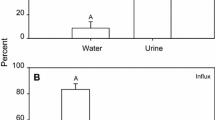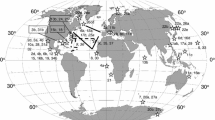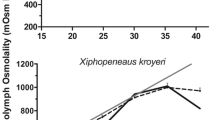Abstract
Activities of the primary enzyme responsible for monovalent ion regulation, Na+-K+-adenosine triphosphatase (Na+-K+-ATPase), were measured in gills of marine teleost fishes with different depths of occurrence (0 to 4800 m), body weights (a range of five orders of magnitude), and locomotory capacities. Specimens were collected off the coasts of California and Oregon in 1983–1989, and at the Galápagos Spreading Center and 13°N East Pacific Rise hydrothermal vent sites in 1987 and 1988, respectively. Except for two hydrothermal vent fishes, deep-sea species had much lower Na+-K+-ATPase activities g−1 gill filament than shallow-living species, indicating that osmoregulatory costs, like total metabolic rate, are greatly reduced in most deep-living fishes. Within a species, the total branchial Na+-K+-ATPase activity per individual was dependent on size; the average allometric scaling exponent was 0.83. Using published values for oxygen consumption rates, and the total branchial Na+-K+-ATPase activities as an index of osmoregulatory costs, we estimated the maximal cost (as percent of ATP turnover) for osmoregulation in ten teleosts. Osmoregulatory costs averaged about 10% of total ATP turnover among these species, and maximal costs were no greater than about 20%. The percent costs of osmoregulation did not differ between shallow- and deep-living fishes. The reduced total ATP expenditure for osmoregulation in deep-living fishes is proposed to result from the sluggish locomotory habits of these fishes, not from selection for reduced osmotic coastper se. Thus, the reduced swimming abilities of these fishes lead to lower rates of water flow over the gills and less blood flow through the gills due to reduced demands for oxygen. Consequently, passive flux of water and ions through the gills is much lower than in more active fishes, and osmotic costs are thereby minimized. The relatively high activities of Na+-K+-ATPase in gills of the two hydrothermal vent fishes suggest that these fishes may be more active and have higher metabolic rates than other deep-sea fishes.
Similar content being viewed by others
Literature cited
Blaxter, J. H. S., Wardle, C. S., Roberts, B. L. (1971). Aspects of the circulatory physiology and muscle systems of deep-sea fish. J. mar. biol. Ass. U.K. 51: 991–1006
Childress, J. J., Nygaard, M. H. (1973). The chemical composition of midwater fishes as a function of depth of occurrence off southern California. Deep-Sea Res. 20: 1093–1109
Childress, J. J., Somero, G. N. (1979). Depth-related enzymic activities in muscle, brain, and heart of deep-living pelagic marine teleosts. Mar. Biol. 52: 273–283
Childress, J. J., Somero, G. N. (1990). Metabolic scaling: a new perspective based on scaling of glycolytic enzyme activities. Am. Zool. 30: 161–173
Cohen, D. E., Rosenblatt, R. H., Moser, H. G. (1990). Biology and description of a bythitid fish from deep-sea thermal vents in the tropical eastern Pacific. Deep-Sea Res. (in press)
Epstein, F. H., Silva, P. Kormanik, G. (1980). Role of Na-K-ATPase in chloride cell function. Am. J. Physiol. 238: R246-R250
Evans, D. E. (1969). Studies on the permeability to water of selected marine, freshwater, and euryhaline teleosts. J. exp. Biol. 50: 689–703
Febry, R., Lutz, P. (1987). Energy partitioning in fish: the activityrelated cost of osmoregulation in a euryhaline cichlid. J. exp. Biol. 128: 63–85
Gibbs, A., Somero, G. N. (1989). Pressure adaptation of Na+-K+-ATPase in gills of marine teleosts. J. exp. Biol. 143: 475–492
Hughes, G. M. (1970). A comparative approach to fish respiration. Experientia 26: 113–124
Hughes, G. M. (1984). General anatomy of gills. In: Hoar, W. S., Randall, D. J. (eds.). Fish physiology. Vol. XA. Academic Press, New York, p. 1–72
Hughes, G. M., Iwai, T. (1978). A morphometric study of the gills in some Pacific deep-sea fishes. J. Zool. 184: 155–170
Itazawa, Y., Oikawa, S. (1983). Metabolic rates in excised tissues of carp. Experientia 39: 160–161
McCormick, S. D., Moyes, C. D., Ballantyne, J. S. (1989). Influence of salinity on the energetics of gill and kidney of Atlantic salmon (Salmo salar). Fish. Physiol. Biochem. 6: 243–254
Miller, D. J., Lea, R. N. (1972). Guide to the coastal marine fishes of California, California Department of Fish & Game, Sacramento
Perry, S. F., Walsh, P. J. (1989). Metabolism of isolated fish gill cells: contribution of epithelial chloride cells. J. exp. Biol. 144: 507–520
Philpott, C. W. (1980). Tubular system membranes of teleost chloride cells: osmotic response and transport sites. Am. J. Physiol. 238: R171-R184
Rao, G. M. M. (1968). Oxygen consumption of rainbow trout (Salmo gairdneri) in relation to activity and salinity. Can. J. Zool. 46: 781–786
Schmidt-Nielsen, K. (1984). Scaling: why is animal size so important? Cambridge University Press, Cambridge
Shelton, C., MacDonald, A. G., Pequeux, A., Gilchrist, I. (1985). The ionic composition of the plasma and erythrocytes of deep-sea fish. J. comp. Physiol. (Sect. B) 155: 629–633
Siebenaller, J. F. (1984). Analysis of the biochemical consequences of ontogenetic vertical migration in a deep-living teleost fish. Physiol. Zoöl. 57: 598–608
Siebenaller, J. F., Somero, G. N. (1989). Biochemical adaptation to the deep sea. CRC critical Rev. aquat. Sciences 1: 1–25
Siebenaller, J. F., Somero, G. N., Haedrich, R. L. (1982). Biochemical characteristics of macrourid fishes differing in their depths of distribution. Biol. Bull. mar. biol. Lab. Woods Hole 163: 240–249
Smith, K. L., Jr. (1978). Metabolism of the abyssopelagic rattailCoryphaenoides armatus measuredin situ. Nature, Lond. 274: 362–364
Smith, K. L., Jr., Brown, N. O. (1983). Oxygen consumption of pelagic juveniles and demersal adults of the deep-sea fishSebastolobus altivelis, measured at depth. Mar. Biol. 76: 325–332
Smith, K. L., Jr., Hessler, R. R. (1974). Respiration of benthopelagic fishes:in situ measurements at 1230 meters. Science, N. Y. 184: 72–73
Smith, K. L., Jr., Laver, M. B. (1981). Respiration of the bathypelagic fishCyclothone acclinidens. Mar. Biol. 61: 261–266
Somero, G. N., Childress, J. J. (1980). A violation of the metabolism-size scaling paradigm: activities of glycolytic enzymes in muscle increase in larger-size fish. Physiol. Zoöl. 53: 322–337
Somero, G. N., Childress, J. J. (1990). Scaling of ATP supplying enzymes, myofibrillar proteins and buffering capacity in fish muscle: relation to locomotory habit. J. exp. Biol. (in press)
Stein, D. L., Pearcy, W. G. (1982). Aspects of reproduction, early life history, and biology of macrourid fishes off Oregon, U.S.A. Deep-Sea Res. (Ser. A) 29: 1313–1329
Stryer, L. (1988). Biochemistry. 3rd ed. W. H. Freeman & Co., New York
Sullivan, K. M., Smith, K. L., Jr. (1982). Energetics of sablefish,Anoplopoma fimbria, under laboratory conditions. Can. J. Fish. aquat. Sciences 39: 1012–1020
Sullivan, K. M., Somero, G. N. (1980). Enzyme activities of fish skeletal muscle and brain as influenced by depth of occurrence and habits of feeding and locomotion. Mar. Biol. 60: 91–99
Sullivan, K. M., Somero, G. N. (1983). Size- and diet-related variations in enzymic activity and tissue composition in the sablefish,Anoplopoma fimbria. Biol. Bull. mar. biol. Lab. Woods Hole 164: 315–326
Torres, J. J., Belman, B. W., Childress, J. J. (1979). Oxygen consumption rates of midwater fishes as a function of depth of occurrence. Deep-Sea Res. (Ser. A) 26: 185–197
Torres, J. J., Somero, G. N. (1988a). Metabolism, enzymic activities and cold adaptation in Antarctic mesopelagic fishes. Mar. Biol. 98: 169–180
Torres, J. J., Somero, G. N. (1988b). Vertical distribution and metabolism in Antarctic mesopelagic fishes. Comp. Biochem. Physiol. 90B: 521–528
Yamamoto, S., Akera, A., Brody, T. M. (1979). Sodium influx rate and ouabain-sensitive rubidium uptake in isolated guinea pig atria. Biochim. biophys. Acta 555: 270–284
Author information
Authors and Affiliations
Additional information
Communicated by J. M. Lawrence, Tampa
Rights and permissions
About this article
Cite this article
Gibbs, A., Somero, G.N. Na+-K+-adenosine triphosphatase activities in gills of marine teleost fishes: Changes with depth, size and locomotory activity level. Mar. Biol. 106, 315–321 (1990). https://doi.org/10.1007/BF01344307
Accepted:
Issue Date:
DOI: https://doi.org/10.1007/BF01344307




